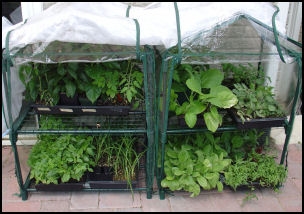So you've transplanted your little seedlings into bigger pots and...now what? How do you decide when to plant them out in the garden? If, like me, you can't see past them out of your kitchen window, that may be telling you something.
On the one hand, you don't want to plant them out too early and have a frost kill them all. On the other hand, planting out at the correct time makes for the best growth and happiest plants.
Even good-quality seed compost will run out of nutrients after about 8 weeks, shown by leaves losing vigorous growth or yellowing. Once the plant has grown about twice as tall as the pot, it may be struggling to retain enough water as its roots take up more space; its leaves will be larger and lose water more quickly. If you carefully turn the pot upside down and look at the roots you can see if they are starting to go round and round the pot (pot-bound) and need more space.
Preferably before any of these signs show, it's time to either relocate into a larger pot with fresh potting soil, or transplant the plants outside. If you take plants straight from their sheltered environment to the outside planting bed, they may be shocked out of existence. Therefore, you must first harden them off.
To do this, start a couple of weeks before you intend to plant the plants outside. Check your last frost date. Over a period of a few days, take the young plants outside to a sheltered spot, no cooler than 45 degrees F, protected from the wind and in weak morning sunshine. Gradually increase the amount of sunlight by an hour or two each day until they're out all day, then you can leave them out overnight if there is no risk of frost. Reduce the water a little, not so much that they dry out, but to encourage the thickening of cell walls so the stems become woodier rather than soft. They may appear to stop growing, but they're getting sturdier to withstand the stresses of being outside. These stresses include greater temperature variations, variation in water supply, direct sunlight that can scorch young leaves, moving air that will increase transpiration, and wind that will try to flatten young plants.
If you're out all day, leave them where they'll get morning sun and afternoon shade and be prepared to bring them indoors at night. A cold frame or an unheated greenhouse are perfect for this process. Be careful of leaving plants on the ground where bugs can crawl in pots and chew on them, birds can feed on the shoots or knock them over looking for grubs.
Given everything that can go wrong, it may also be worthwhile keeping a few plants indoors in case something happens to the early plants. Once they can tolerate full sun and are tough enough to stand upright on their own, it's time to consider moving them to their summer home.
Next up: Planting out
